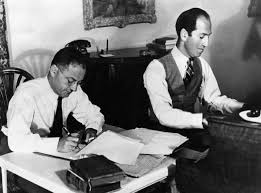PEDAL PUSHER
On July 5, 1894 a young married mother of three embarked on a journey. Sponsored by a water company with a stake of $100, she changed her name, and the future of women. Annie Londonderry's journey across the world via bicycle may have been a bit dubious, but she gave women freedom in both transportation and fashion. With $10,000 and the pride of women at stake, Annie Kopchovsky pedaled her way into history.
Annie Cohen was born in Latvia in 1870. Her parents immigrated with Annie, her older sister, and younger brother to Boston in 1875. With both parents deceased when Annie was 17 and her older sister married, Annie and her younger brother Bennett took care of their younger siblings. In 1888 she married Simon "Max" Kopchovsky. Annie and Max had three children. Max was a peddler and Annie sold advertising for several Boston newspapers.
According to Annie's story two Boston businessmen, sure that a woman could never complete the trip, offered $10,000 to a woman who could ride a bicycle around the world in less than 33 days - the record set by the first man to do so. These men were never named and no proof was found of the challenge officially being issued. Annie rode a bicycle for the first time 5 days before her trip began. The Pope Manufacturing Company presented Annie with a new bicycle. The Londonderry Lithia Spring Water Company handed Annie $100 in exchange for hanging a sign from her bike. Annie changed her last name to Londonderry for the trip. With a change of clothes, and a pearl handled pistol, Annie headed off.
She cycled to Chicago, but after realizing she would meet inclement winter weather heading West, she turned East to New York City. The trip did not specify miles, only duration. Annie sailed to France, disembarked, and rode across France to Marseille. She then sealed to Alexandria, then Yemen, and biked across Asia. She sailed from Japan to San Francisco, then biked East to Chicago. She earned money on her trip by lecturing about her travels. She sold autographs, photos, and souvenir pins. She also took sponsorships by attaching ribbons with product names to her clothes. The woman who once sold advertising was a literal bike riding billboard.
Any eschewed typical feminine attire for bloomers - short pants that gave women freedom of movement. Bloomers were considered improper for women. Bicycle riding, a trendy new fad, was also scandalous for women. Until women had bicycles, poor women were mostly homebound. If a woman had a bicycle, she could transport herself, a revolutionary concept for the late 1890s. Annie set a fashion trend and secured Independence for women.
On September 12th, 1895 Annie arrived in Chicago to accept her $10,000 prize, 14 days earlier than her allotted time. Annie continued to lecture about her travels, possibly exaggerating what actually happened. She became a reporter for the New York World, reporting on her life as one of the "new women" of the era. Annie and Max had a fourth child. Annie relocated for a time to Northern California, but resided with her family in the Bronx. The family ran two businesses until Annie died of a stroke at age 77 in 1947. While wearing her bloomers, Annie Londonderry gave new meaning to the term pedal pusher.
SOURCES :
Annie Londonderry. Wikipedia.
Ward, Tom. Annie Londonderry Barely Knew How to Ride a Bike When She Set Off Around the World. Atlas Obscura. 18 March 2022.
BOOKS :
Spin : A Novel Based on a (Mostly) True Story ~ Peter Zheutlin
Frey, Holly / Wilson, Tracy V., hosts. "Annie Londonderry's Dubious Bike Trip Around the World." Stuff You Missed In History Class, iheartradio, 6 April 2020.
Graham, Beckett / Vollenweider, Susan, hosts. "Annie Londonderry." The History Chicks, EPISODE 123, Wondery, 7 April 2019.
Nelson, Katie Dr. / Meikle, Olivia, hosts. "The Round the World Cyclist - Annie Londonderry." What'sHerName, Nelson, Katie Dr. / Meikle, Olivia, 3 May 2021.
Vogelbaum, Lauren, host. "Like the Wind." American Shadows. (Grim & Mild, 15 June 2023.




Comments
Post a Comment